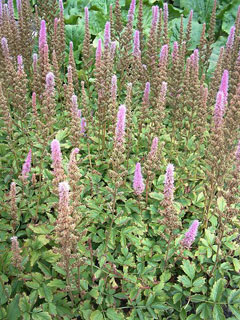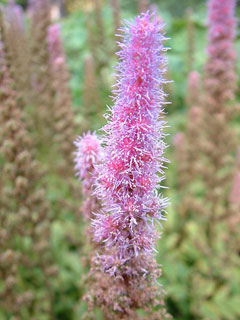 |
|
http://commons.wikimedia.org/wiki/User:Radomil |
 |
| http://commons.wikimedia.org/wiki/User:Radomil |
Translate this page:
Summary
Bloom Color: Pink, White.
Main Bloom Time: Late summer. Form: Upright or erect.
Physical Characteristics

 Astilbe chinensis is a PERENNIAL growing to 0.7 m (2ft 4in) by 0.5 m (1ft 8in) at a medium rate.
Astilbe chinensis is a PERENNIAL growing to 0.7 m (2ft 4in) by 0.5 m (1ft 8in) at a medium rate.
See above for USDA hardiness. It is hardy to UK zone 5. It is in flower from July to August. The species is hermaphrodite (has both male and female organs) and is pollinated by Insects.
Suitable for: light (sandy), medium (loamy) and heavy (clay) soils. Suitable pH: mildly acid, neutral and basic (mildly alkaline) soils. It can grow in semi-shade (light woodland). It prefers moist or wet soil.
UK Hardiness Map
US Hardiness Map
Synonyms
Plant Habitats
Woodland Garden Dappled Shade; Shady Edge; Bog Garden;
Edible Uses
Edible Parts: Leaves Shoots
Edible Uses:
Young shoots[177]. No more details are given.
References More on Edible Uses
Medicinal Uses
Plants For A Future can not take any responsibility for any adverse effects from the use of plants. Always seek advice from a professional before using a plant medicinally.
None known
References More on Medicinal Uses
The Bookshop: Edible Plant Books
Our Latest books on Perennial Plants For Food Forests and Permaculture Gardens in paperback or digital formats.

Edible Tropical Plants
Food Forest Plants for Hotter Conditions: 250+ Plants For Tropical Food Forests & Permaculture Gardens.
More

Edible Temperate Plants
Plants for Your Food Forest: 500 Plants for Temperate Food Forests & Permaculture Gardens.
More

More Books
PFAF have eight books available in paperback and digital formats. Browse the shop for more information.
Shop Now
Other Uses
Landscape Uses: Border, Container, Massing, Rock garden, Woodland garden. There are some named varieties, selected for their ornamental value[233]. A first class ground cover plant, the lower-growing cultivar 'Pumila' is particularly recommended[233]. Special Features:Attractive foliage, Suitable for dried flowers. Dynamic accumulator.
Special Uses
Dynamic accumulator
References More on Other Uses
Cultivation details
Prefers a rich garden soil, but succeeds in most soils so long as they stay reliably moist in the summer[1, 233]. Requires a wet or moist peaty soil in sun or partial shade[187], growing well under shrubs[233]. Prefers a pH in the range 5.5 to 7[200]. Prefers partial shade[200], especially if the soil is on the dry side[233]. Plants are hardy to about -20°c[187]. Members of this genus are rarely if ever troubled by browsing deer or rabbits[233]. There are some named varieties, selected for their ornamental value[233].
References Carbon Farming Information and Carbon Sequestration Information
Temperature Converter
Type a value in the Celsius field to convert the value to Fahrenheit:
Fahrenheit:
The PFAF Bookshop
Plants For A Future have a number of books available in paperback and digital form. Book titles include Edible Plants, Edible Perennials, Edible Trees,Edible Shrubs, Woodland Gardening, and Temperate Food Forest Plants. Our new book is Food Forest Plants For Hotter Conditions (Tropical and Sub-Tropical).
Shop Now
Plant Propagation
Seed - we have no details for this species but suggest sowing the seed in a greenhouse in early spring. Only just cover the seed. When large enough to handle, prick the seedlings out into individual pots and grow them on in a cold frame until they are at least 20cm tall. Plant them out in the summer, or late in the following autumn. Division in spring. This is best done every 3 - 4 years in order to maintain the vigour of the plant[200]. Larger divisions can be planted straight into their permanent positions whist smaller clumps are best potted up and kept in a cold frame until they are growing away well.
Other Names
If available other names are mentioned here
Native Range
TEMPERATE ASIA: Russian Federation (Primorye, Amur), China (Zhejiang Sheng, Heilongjiang Sheng, Henan Sheng, Hebei Sheng, Hunan Sheng, Hubei Sheng, Gansu Sheng (southeast), Jiangxi Sheng, Jilin Sheng, Liaoning Sheng, Shanxi Sheng, Shandong Sheng, Shaanxi Sheng, Sichuan Sheng, Qinghai Sheng (southeast), Yunnan Sheng), Korea, Japan (Kyushu (Tsushima))
Weed Potential
Right plant wrong place. We are currently updating this section.
Please note that a plant may be invasive in one area but may not in your area so it's worth checking.
Conservation Status
IUCN Red List of Threatened Plants Status :

Growth: S = slow M = medium F = fast. Soil: L = light (sandy) M = medium H = heavy (clay). pH: A = acid N = neutral B = basic (alkaline). Shade: F = full shade S = semi-shade N = no shade. Moisture: D = dry M = Moist We = wet Wa = water.
Now available:
Food Forest Plants for Mediterranean Conditions
350+ Perennial Plants For Mediterranean and Drier Food Forests and Permaculture Gardens.
[Paperback and eBook]
This is the third in Plants For A Future's series of plant guides for food forests tailored to
specific climate zones. Following volumes on temperate and tropical ecosystems, this book focuses
on species suited to Mediterranean conditions—regions with hot, dry summers and cool, wet winters,
often facing the added challenge of climate change.
Read More
Expert comment
Author
(Maxim.)Franch.&Sav.
Botanical References
74200266
Links / References
For a list of references used on this page please go here
Readers comment
| Add a comment |
|
If you have important information about this plant that may help other users please add a comment or link below. Only comments or links that are felt to be directly relevant to a plant will be included. If you think a comment/link or information contained on this page is inaccurate or misleading we would welcome your feedback at [email protected]. If you have questions about a plant please use the Forum on this website as we do not have the resources to answer questions ourselves.
* Please note: the comments by website users are not necessarily those held by PFAF and may give misleading or inaccurate information.
To leave a comment please Register or login here All comments need to be approved so will not appear immediately.
|
Subject : Astilbe chinensis
|
|
|
|